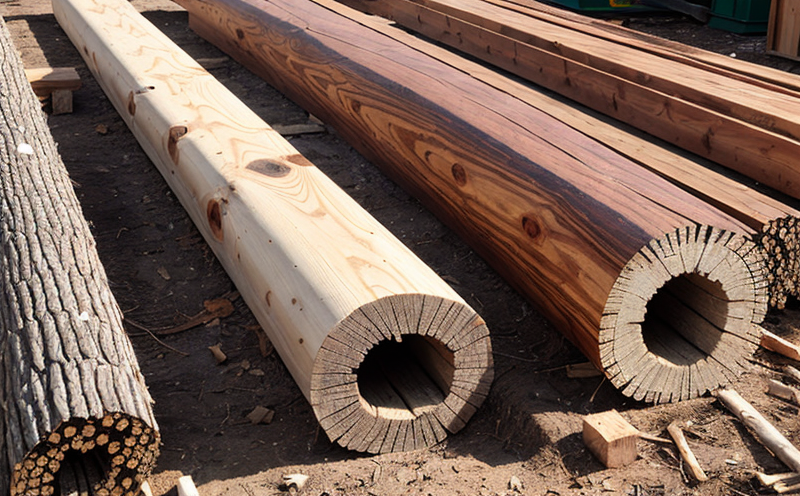Micronized Copper Preservative Testing in Wood
Micronized copper preservatives have become a popular choice in wood preservation due to their effective fungicidal and antimicrobial properties. This testing service ensures that the micronized copper used in wood products meets stringent standards for durability and performance. The process involves several critical steps, each aimed at ensuring that the preservative is both effective and environmentally responsible.
The first step in our testing procedure is to ensure that the wood specimens are prepared correctly. This includes selecting appropriate samples that accurately represent the intended application of the micronized copper preservative. Specimens are then treated with the preservative according to specified protocols, which may vary based on the type and size of the wood being tested.
Following treatment, the specimens undergo a series of accelerated aging tests using various environmental conditions that simulate real-world exposure. These conditions include high humidity, UV light exposure, and temperature fluctuations. The purpose is to hasten the natural degradation processes that occur over time in the field environment, allowing us to assess the preservative’s performance more quickly.
During these accelerated aging tests, we monitor key parameters such as weight loss, color change, and surface texture changes. These observations provide valuable insights into how well the micronized copper is protecting the wood against fungal decay and insect infestation. The use of standardized testing methods ensures that our results are reliable and can be compared with other products on the market.
The next step in the process involves microbiological assessments to determine the preservative’s efficacy against common wood-degrading organisms. This is typically done using agar plate cultures where fungi and bacteria are grown around treated specimens. The presence or absence of growth provides evidence of the preservative's effectiveness in inhibiting microbial activity.
Environmental impact considerations are also crucial, as micronized copper can have a significant effect on ecosystems when it leaches into soil and water. We perform leaching tests to quantify the amount of copper that may be released from treated wood over time. This helps us understand the potential environmental risks associated with using this preservative.
Finally, we provide detailed reports summarizing all test results. These reports include graphical representations such as weight loss curves, color charts, and images documenting surface changes. They also contain a comprehensive analysis of microbiological findings and leaching data. This information is invaluable for quality managers, compliance officers, R&D engineers, and procurement teams who need to make informed decisions about the use of micronized copper preservatives in their products.
- Weight loss curve: Graphical representation showing how much weight a specimen loses over time due to degradation processes.
- Color chart: Documentation of any changes in the coloration of treated wood specimens as an indicator of preservative effectiveness.
- Surface change images: Visual evidence capturing alterations on the surface of wood samples after undergoing accelerated aging tests.
Applied Standards
The testing procedures for micronized copper preservative in wood are governed by several international standards, including ISO and ASTM. These standards ensure that our methods and results are consistent with industry best practices and regulatory requirements.
- ISO 6380: This standard provides guidelines for the testing of wood preservatives, which is essential in validating the effectiveness of micronized copper treatments.
- ASTM D1413: Focuses on the accelerated weathering test methods for wood, providing a framework to simulate real-world conditions and assess the durability of treated wood products.
Our laboratory adheres strictly to these standards, ensuring that our testing is both accurate and reliable. Compliance with such internationally recognized guidelines enhances confidence in the results we provide, making it easier for clients to meet regulatory requirements and industry expectations.
Eurolab Advantages
At Eurolab, we pride ourselves on offering a comprehensive range of testing services tailored specifically to the needs of our clients in the agricultural and forestry sectors. Our expertise lies not only in providing accurate test results but also in delivering actionable insights that can drive innovation and improve product performance.
- Comprehensive Testing Capabilities: We offer a full suite of tests for wood durability and preservation, including those specifically focused on micronized copper preservatives. This ensures that our clients have access to all the necessary information required to make informed decisions about their product development processes.
- State-of-the-Art Facilities: Equipped with cutting-edge equipment and facilities, we ensure that every test conducted is done under controlled conditions that mimic real-world scenarios as closely as possible. This leads to more accurate and relevant results.
- Experienced Staff: Our team comprises highly skilled professionals who have extensive experience in the field of wood preservation testing. They bring a wealth of knowledge to every project, ensuring that our clients receive expert advice along with high-quality test outcomes.
- Dedicated Client Support: Throughout the entire testing process, we offer round-the-clock support from our dedicated client services team. This includes technical consultations, result interpretation, and assistance with any queries or concerns related to the tests conducted.
Use Cases and Application Examples
The use of micronized copper preservatives in wood offers numerous benefits across various industries. From construction materials to outdoor furniture, this treatment ensures that wooden products remain durable and resistant against pests and environmental factors for extended periods.
- Construction Materials: In the building sector, treated wood is used extensively for structural elements like beams, columns, and joists. The added protection provided by micronized copper helps these components withstand harsh weather conditions without deteriorating prematurely.
- Outdoor Furniture: For manufacturers of garden furniture, using preservative-treated wood ensures that their products last longer outdoors where they are exposed to rain, sun, and temperature variations. This extends the life cycle of the furniture while maintaining its aesthetic appeal.
- Traffic Fencing: In public spaces such as parks and playgrounds, traffic fencing made from micronized copper-treated wood is less prone to rotting or splintering, providing safer boundaries for pedestrians and vehicles alike.





